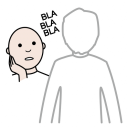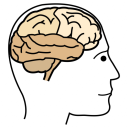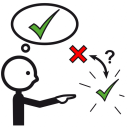Serious Games and Alzheimer
- What are Serious Games?
- What are the benefits of using Serious Games with people with dementia?
- What are the barriers to using Serious Games with people with dementia?
What are Serious Games?
Serious games (SGs) are digital applications or games that can be used for entertainment but also have other important purposes, such as training and educating, communicating, or promoting the use of cognitive, physical and social abilities. SGs are often specifically designed and targeted at certain populations such as people with dementia; however, more recent research has suggested that commercially available gaming technology can also be used to benefit the well-being of people with dementia and their care partners. For the purposes of this project, the SGs outlined on the website will include games that are both technological and non-technological based and that have either been designed for a specific purpose or are more commercially available.
What are the benefits of using Serious Games with people with dementia?
Emerging research in the field has suggested that SGs can provide a range of potential benefits for people with dementia and their care partners. These include opportunities for people to:
- Play with fun, novel devices and learn something new
- Challenge themselves to master new and sometimes complex skills
- Engage in games that promote mental and cognitive stimulation, mild physical exercise and social interaction as well as enhance mood
- Re-engage with games that they may have played in the past but are no longer able to
- Increase self-confidence by challenging perceptions of their own capabilities
- Interact with younger family members
- Challenge public views on dementia and raise awareness of the capabilities of people living with the condition
Although research in this field is still very new, it is likely that as it develops there will be a better understanding of the range of benefits it can afford people with dementia and their care partners.
What are the barriers to using Serious Games with people with dementia?
Although research continues to show SGs may offer benefits for people with dementia and their care partners, the uptake of such applications is still low. This has been attributed to a range of barriers, including:
- Poor understanding of what games are available
- A fear of using the technology
- Difficulties purchasing the technology due to high costs or lack of availability on the commercial market
- A believe from health and community practitioners that people with dementia and their care partners are uninterested in, and incapable of, using the technology
- Health and community practitioners’ lack of knowledge, confidence and expertise in how to use the gaming technology with people with dementia and their care partners
Therefore, this website has been designed to raise awareness, and encourage the use of SGs amongst people with dementia, their care partners and practitioners by providing recommendations for overcoming some of the barriers outlined above.
Cognitive Dimensions
There are strong evidences that stimulation of cognitive abilities helps slow the loss of functions and abilities, consistently improves cognitive functions and is also associated with benefits of Quality of Life and communication.
The games proposed at the AD-GAMING platform are specifically selected to work with one or more of the following Cognitive Dimensions:
The pictograms used are property of Aragon Goberment and have been created by Sergio Palao to ARASAAC (http://arasaac.org) which distribute them under Creative Commons License (BY-NC-SA)
Recommendations
- How can people with dementia be supported to use Serious Games?
- How can feedback on using Serious Games be collected from people with dementia?
- How to involve professionals, users and relatives?
How can people with dementia be supported to use Serious Games?
There are a number of guides currently available that aim to support health practitioners wishing to use a range of technologies with people with dementia, including Assistive Technology (AT), Information and Communication Technology (ICT), computers and commercial gaming technology. Some examples are:
- Alzheimer’s Society. (2014). Dementia-friendly Technology Charter. London: Alzheimer’s Society.
- Savitch, N. and Stokes, V. (2011). We can do I.T. too: Using computers as part of activity programmes for people with dementia. London: Speechmark.
- Social Care Institute for Excellence. (SCIE) (2012). Using ICT in activities for people with dementia. London: SCIE
- Hicks, B. Innes, A. Nyman, S. & Cash, M. (2016). A ‘How to’ Guide: Setting up and running gaming technology groups for people with dementia. Bournemouth University: BUDI
It is advisable for practitioners to also consult these guides so that they are aware of, and confident with, the technology before attempting to engage people with dementia and their care partners. Research has demonstrated that if practitioners lack the confidence and knowledge to engage people with dementia with technology then any attempts to do so are likely to fail.
Whilst the guides illustrated above cover a broad range of technologies, the aim of this website is to provide more specific information and recommendations on using SGs with people with dementia and their care partners. The recommendations set-out below are based on that obtained from research within the field.
1: Ensure there is prior interest in the technology and SGs
Although practitioners may wish to use SGs with people with dementia and their care partners it is important that they firstly explore whether there is an interest for this. If people with dementia and their care partners have no interest in learning about the technology or engaging with it, then any SG initiative is likely to fail from the very start. It is advisable that practitioners approach their intended audience, prior to purchasing any technology, to establish whether this is something that would be of interest.
However, it is also important to consider that a lot of people with dementia and care partners will be unaware of the technology available for them to use, and consequently may also be fearful of it. In these situations, it is advisable that practitioners bring some of the technology they intend to use along with them to these preliminary meetings and use it as part of a ‘taster session.’ During this ‘taster session’ practitioners can display the technology and SGs they are interested in using and explain some of the benefits that they may provide (drawing on the list outlined in Section 2). It may also be useful to refer to the technology as ‘gadgets’ as this is likely to remove some of the fear that can be associated with the word ‘technology.’
2: Purchasing the technology and SGs
Some SGs have been designed specifically for people with dementia by gaming engineers. As such, these tend to be unavailable on the commercial market and it is likely that practitioners will be obliged to contact the lead designers or researchers if they wish to use the SGs with their intended audience.
However, other SGs and technological platforms (and particularly the ones that are promoted on this website) are widely available for purchase. It is advisable that practitioners explore a range of websites to compare costs. Some websites may provide a ‘used/like new’ section where technological platforms and SGs can be purchased at a cheaper price.
3: The technological platforms
Some of the SGs promoted on this website are non-technological and therefore the purchase of a technological platform is not required. However other SGs will require practitioners to purchase a commercially available technological platform. Table 1 below highlights some of the more up-to-date technological platforms that have been used with people with dementia, alongside the specific benefits and challenges they can offer, as well as advice on overcoming practical issues with using the device. It is important that practitioners are aware of the challenges of some technological platforms so that they can tailor them to the specific group of people they wish to work with. For instance the Microsoft Kinect is likely to be a challenge for a group of people with dementia who all require wheelchairs for mobility.
Table 1: Up-to-date technological platforms for running Serious Games
| Technological platform | Benefits | Challenges | Overcoming issues |
| Tablets (e.g. iPad) | Portable device that can be linked to the internet. Touchscreen is more intuitive than mouse and keyboard. | Small screen can be difficult to view.
Screen can be oversensitive. Can be difficult to hold and interact with the SG. Can be difficult for people with finger dexterity issues. |
TV connector can be purchased to play the SG through the TV making it easier to see.
‘Air’ versions of tablets are lighter to hold. A stylus can be purchased to make it easier to interact with the screen. |
| Microsoft Kinect | Players are not required to use a controller or push buttons.
SGs are very intuitive. |
Sensor technology can become confused with devices such as wheelchairs. Players can still engage with walking sticks.
Sensors can detect others players within the vicinity and this can hinder playability. |
Players can be supported to engage with the game whilst they are out of their chair.
Practitioners should ensure that only those playing the game are in-front of the sensor. |
| Nintendo Wii | The sensor will only detect those players that are holding a controller.
Players can sit whilst playing the games. |
Some games require difficult button combinations as well as physical movements.
Controllers can be oversensitive and may come out of people’s hands. |
Accessories such as a steering wheel, can support interaction with games and overcome difficulties.
A safety strap is provided on the controllers. |
4: Involving volunteers
If SGs are being used with a group of people with dementia and their care partners, then it may be beneficial for practitioners to also consider using volunteers to support the process. In the preliminary stages, people with dementia may require a lot of support to engage with the SGs. This means that practitioners are likely to be required to spend a lot of time with each individual player. As such, volunteers can help to support this process and also continue to engage other people with dementia whilst the practitioner provides the necessary support to the SG players. This also means that those people with dementia who are not engaging with the SGs do not become bored and restless.
5: Creating the right environment for using Serious Games with people with dementia
Creating an environment where people feel safe to engage with the SGs is very important. When using sensor technology such as the Nintendo Wii or the Microsoft Kinect then it is important that players have enough space to move around without fear of hitting others. The television should be positioned at eye level and the sensor can be placed above or below this. It may also be worth placing other chairs in a semi-circle around the television screen (but at a safe distance from the players) so that those not engaging with the games can still watch. This means that even if people are not playing the SG then they can feel a sense of enjoyment from it.
When using SGs that require people to sit down to interact with them then it is important that practitioners provide a space where players can sit at a table. Arranging the tables in a circular fashion will also encourage people to socially interact as they engage with the SG. Practitioners may also wish to consider having care partners sit and watch the SGs even if they don’t interact with them. Research has shown that this can challenge some of their views of the capabilities of people with dementia and is also likely to encourage socialisation between the care partner and person with dementia.
Between 1.5 and 2 hours is probably the optimal time for engaging people with dementia with SGs. This provides enough time for people with dementia to play the SG at their own pace, and provide feedback on their experience. Any shorter and people may feel rushed, and any longer and people may begin to disengage.
6: Supporting people with dementia to interact with the technology
It is important that people with dementia are enabled to interact with the SGs and the technology independently. Practitioners should be aware of the support they provide players and ensure that it is not over-controlling. For example, if users struggle to hold the weight of the tablet as well as interact with it, then practitioners should avoid taking over the game, but instead hold the tablet to enable the player to engage with the game with both hands. Similarly, practitioners should consider having their own controller when instructing people with dementia to use the Nintendo Wii. This way they can point to the button or carry out the action on their controller whilst instructing the player to do likewise on theirs. Of course, on occasions and with certain people (depending on their capabilities) it may be necessary to provide more support but it is important for practitioners to be mindful that their aim is to empower people with dementia whilst they interact with the game.
When first engaging people with dementia with SGs, practitioners would be advised to begin by using simple games and to attempt to tailor these to the interests of the players. Research has shown that people with dementia are more likely to interact with activities if they are tailored to their personal interests. It is important that practitioners find out this information prior to running SG sessions with people with dementia. Where applicable, it is also beneficial to keep the volume high on the SGs. Often the music is fun and engaging, and this is likely to encourage people to interact with the game.
Easier SGs tend to be those games that have slower graphics, have relatively straight-forward goals and do not require complicated movement and button combinations. It is important that practitioners assess the difficulty level of the games before engaging people with dementia. If a game is too hard for a person, then they are likely not to return to it and this may discourage them from attempting to play any other SGs in the future. Most SGs offer difficultly settings and so it is important for practitioners to ensure that these are set to the easiest level at the beginning; they can always be adjusted as players improve on the games.
Practitioners may find that certain people with dementia are more confident at engaging with the SGs then others. In these instances, practitioners would be advised to encourage the more confident people to play the game first and enable those who are less confident to watch. This is likely to reassure those who were initially apprehensive and so inspire them to also play the SG. It may also be possible for practitioners to pair up the more confident players with those that are less confident, and so encourage them to work together to engage with the SG. Encouraging players to engage with group-based SGs is a good way to promote social connections and conversations.
Why invest in sensor technology and tablets?
Sensor technology such as the Nintendo Wii and the Microsoft Kinect, or tablets such as the iPad do come at a cost, and unfortunately, at present there is no free alternative to these systems. However, this should not put people off purchasing them. Whilst the initial outlay may be a little costly- although the prices for the technology are reducing as newer versions become available- they provide access to a great range of fun, colourful and engaging games that are not available on other free platforms. Our experiences suggest that people with dementia enjoy engaging with these systems and the range of games associated with them can appeal to all interests. In addition, they enable players the opportunity to learn new games, interact with modern technology and challenge myths that people with dementia have neither the capability nor interest in engaging with technology.Furthermore, growing academic research within this field supports our assertions and has highlighted the benefits of off-the-shelf digital gaming technology for the healthy ageing, inclusion and well-being of people with dementia.
Therefore, it is important that practitioners see beyond the initial expense of the technology and instead focus on the range of possibilities and benefits that are afforded people with dementia when engaging with these systems.
How can feedback on using Serious Games be collected from people with dementia?
It is important that practitioners regularly collect feedback on the appropriateness and enjoyableness of the SGs from people with dementia and their care partners. This feedback can be used to inform future sessions and decisions on other SGs that users may wish to play. Quantitative measures (such as questionnaires on Quality of Life or well-being) can be used, although these are often not subtle enough to pick up on ‘in-the-moment’ benefits for people with dementia. As such, the best way to obtain feedback on the SGs is to ask those people playing the games and watch them as they interact with them. This qualitative data will ensure that practitioners can continue to engage people with dementia in SGs that will appeal to them and therefore likely to bring them benefits.
When engaging in feedback discussions, practitioners would be advised to not focus solely on those members who are more outgoing or loud. Whilst the information they provide will be important it may not be representative of the whole group. It is essential that practitioners also look to include the quieter members in the conversations as well. Practitioners would also be advised to adjust their approach when engaging people with dementia for feedback. Some may respond better in a group situation where as others may be better in a one-to-one situation.
How to involve professionals, users and relatives?
Being part in the care of a person with Alzheimer’s disease can be rewarding and challenging. The level and intensity of care will vary and increase as the disease progresses.
Several interventions can be done to improve the quality of life of Alzheimer persons. Aside from classical therapeutic and pharmacological tools, the use of games is a possibility that is increasingly being used in the care programs of people with Alzheimer.
The games, besides their playful dimension, contribute to the health, development and maintenance of physical, psychological, affective and social capacities.
Depending on the game, the characteristics of the person with Alzheimer and the objective to use, the games should be used collaboratively or individually.
To facilitate the motivational use of the game and the involvement of users, professionals and family members, it is necessary to take into account the following points:
- – Plan the activities: Make an initial plan: goals, game characteristics, development of the intervention, schedule and evaluation. Some aspects should be considered:
- The characteristics of the person with Alzheimer’s and their caregivers.
- The definition clear action objectives, acting as reference framework for caregiver, professional and person with Alzheimer’s disease
- The organization of leisure activities must imply a structuration of the process: consolidating theory with practice, evaluating the results attending to the objectives and their attainment, both individually and in-group, using group dynamics in their development.
- The game, in addition to its playful component, should facilitate a quality interaction with the caregiver.
- The game should be played regularly.
- – Motivate all participants:
- The use of the game must be motivating and satisfying for all
- The motivation should be directed to the preferences, interests and capacities of the participants. Forcing lost capacities can produce demotivation. It is advisable to reinforce preserved capacities.
- The use of the game should not create frustration or rejection.
- The person with Alzheimer must agree to start and stay in the game session.
- The game should be useful to create a trustful climate based on an easy communication, adaptability, dynamism, tolerance, initiative, self- confidence and acceptance.
- – Choose properly the place of development of the activity:
- The place where the activities are implemented is fundamental, it will influence the climate of cohesion, the type of activities and the resources. In this sense, it is necessary to take into account the environment where the intervention will take place: home, day centre, association, etc.
- Depending on the location, the activities will be carried out jointly with professionals, family, volunteers, neighbourhood, friends, etc. Always with proper training and information.
- – Choose the right game:
- It is necessary to make a selection of the game according to the preferences, abilities, motivation and personal characteristics of the Alzheimer person. It is also necessary to take into account the characteristics of the caregiver or relative.
- It will be necessary to select the games according to the purpose of the intervention.
- – Communication is very important:
- Do not talk to the person with Alzheimer’s disease as a child neither as a grandfather.
- A calm and caring environment is essential.
- Explain everything that is not well understood. It should be important to adapt previously the instructions.
- – Respect people’s rhythms:
- Each person has a rhythm and a work capacity that must be respected.
![]()








